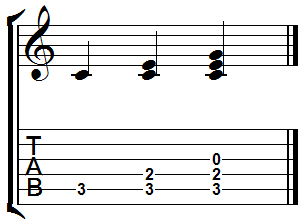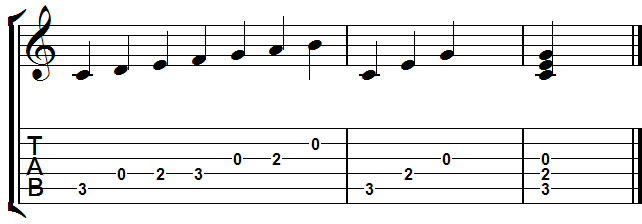Introduction to Chords
A Chord is performed by playing multiple notes simultaneously. Its purpose is to create harmony to
support the melody. A chord gets its name from its root note (C in the C major chord) and the chord’s type (major for a C major chord).
The notes of a chord, with the exception of the root note, determine the chord’s type (major, minor, etc.). A chord type can also be written
with a suffix (suspended fourth chord type is Sus4). These chord lessons will explore several methods of constructing chords, as well as combining
chords to create many chord progressions and cadences.
How to Build Chords
Chords are built using intervals or taking specific notes from a scale. The first example will be building a C major chord using
intervals. This chord has the three notes C, E, and G. Start on the root note (C) and add a major third interval from the root (E), and
add a perfect fifth from the root (G). These same results can be achieved with intervals by starting on the root note (C) and adding a
major third interval (E). Then, from the E note, add a minor third interval (G). Figure 1 below demonstrates this example.

Figure 1 -
C Chord Construction
The second example is to build a chord by taking specific notes from a scale. Every chord can be built using a particular scale. Major
chords can be built using a major scale, and minor chords can be built using a minor scale. For example, when building a C major chord, the
C major scale is used. Remember the notes in a C major scale are C, D, E, F, G, A, and B. The specific notes needed to build a major chord
are the major scale’s first, third, and fifth steps (1, 3, 5). In a C major scale, those notes are C, E, and G. So, a C major chord is built
with the notes C, E, and G. Figure 2 below demonstrates this example.

Figure 2 -
C Major Scale, C Major Arpeggio, C Major Chord
This same process can be used to build any chord. Each chord will have its own step number formula, which is based on the major
scale. These step numbers represent which notes are required to build a particular chord. Also, remember to keep the root note for the
chord and scale the same. The link below shows many of the most common chords, along with their notes and step number formula. Recall, the
step numbers are the notes from the root note’s major scale because every chord formula is based on the major scale. Please take ample time
to study and practice this table.
The following PDF link, Common Chord Types, shows a long list of many common and exotic chord names, their formula, and notes in the Key of C.
It will take some time before all these chords
become memorized. Remember to use similar chords to help remember the more difficult chords by identifying the small
differences.
Common Chord Types - This PDF reguires Adobe Reader